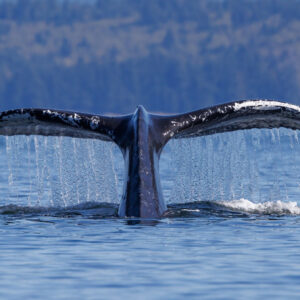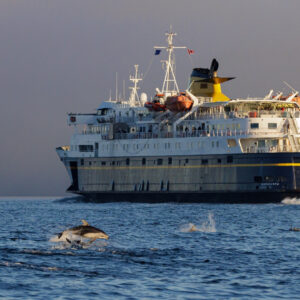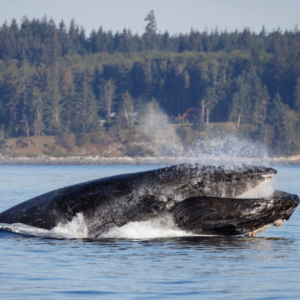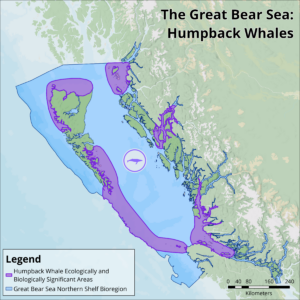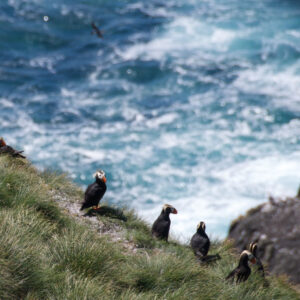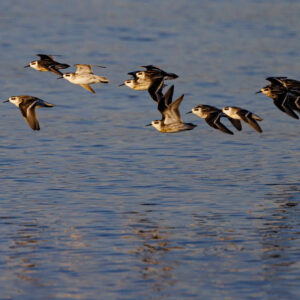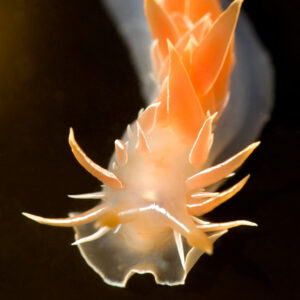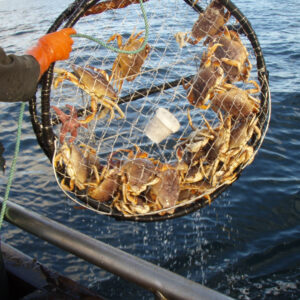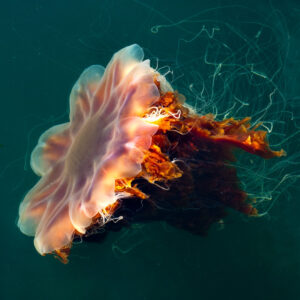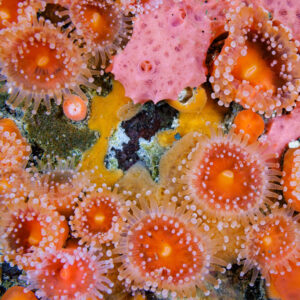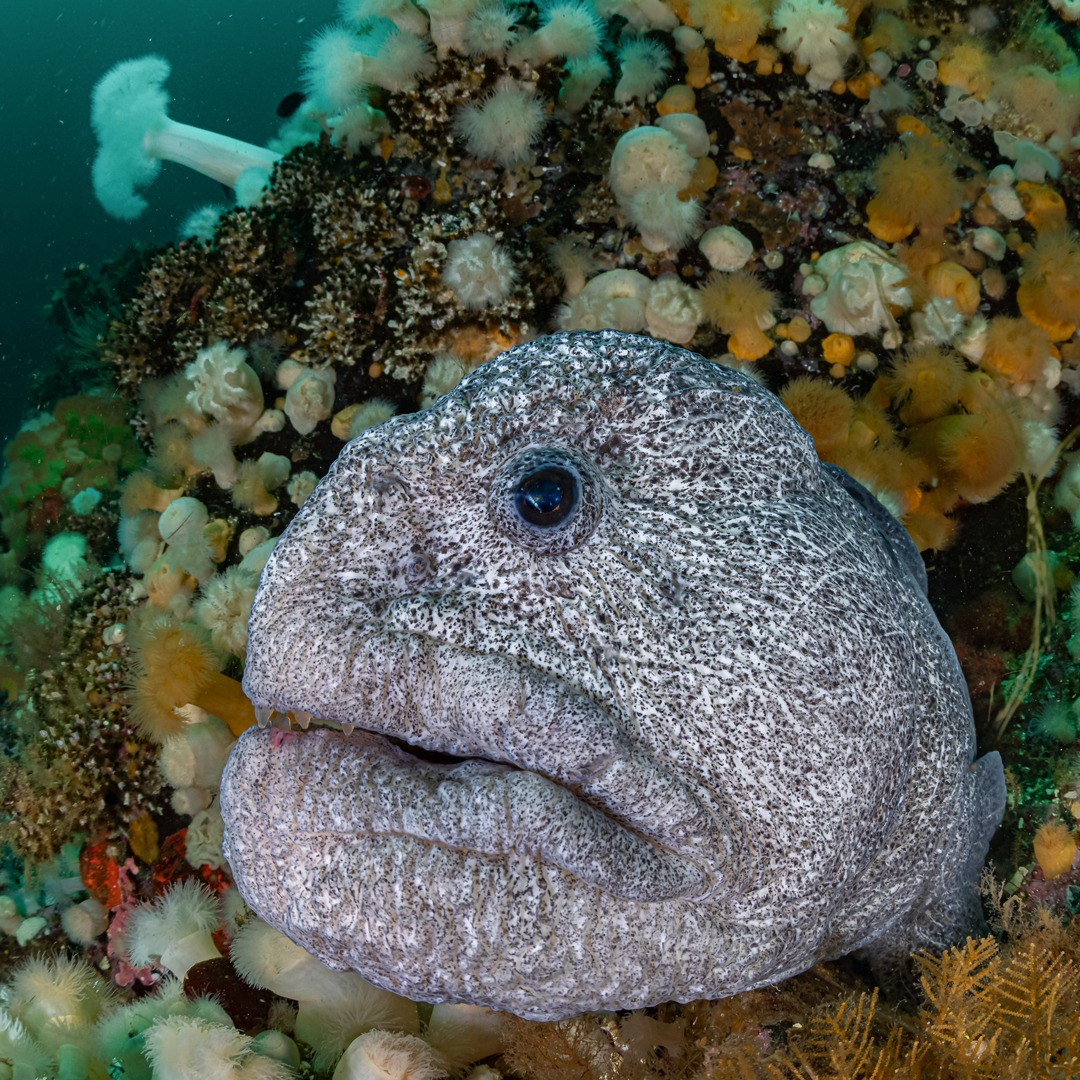
Marine
VEGETATION
These waters are among the most productive coldwater marine environments on the planet. An incredible diversity of animal, plant and seaweed species support a complex food web, ranging from tiny algae to gigantic whales. This abundance offers many benefits to communities along the BC coast, providing sustenance, livelihoods, recreation and more.
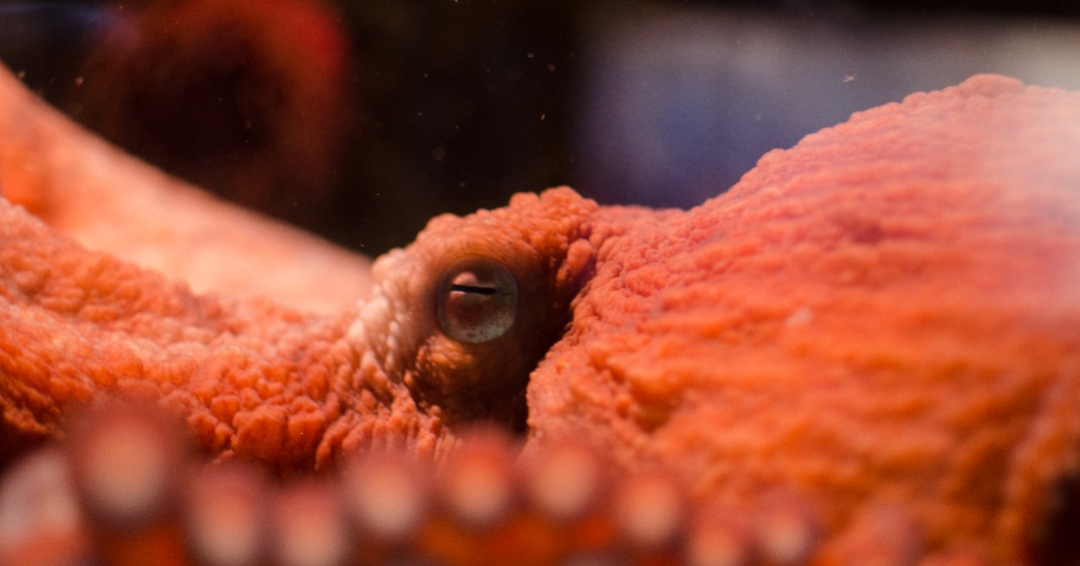
Kelp, Eelgrass, and
SALT MARSHES
These waters are home to kelp forests, eelgrass meadows, and salt marshes. These coastal habitats produce much of the plant material that animals depend on. Underwater beds of seagrass act as nurseries, offering both food and refuge for smaller fish and baby crab. Dense underwater kelp forests provide both protection from predators, and a habitat for animals like sea otters to hunt. These habitats are important for commercially harvested species such as juvenile cod, crab, and rockfish.
Eelgrass
HABITAT
Eelgrass is one of the most prominent seagrasses in BC, growing along 25-35% of the BC coast. In the Skeena River estuary, eelgrass meadows serve as nurseries for baby shellfish and fish, including young salmon. These habitats also capture excess nutrients to prevent harmful algae blooms, and their root systems stabilize shorelines from erosion and extreme weather.
Despite their many benefits, eelgrass meadows are one of the most threatened habitats in the world. Marine protected areas can protect eelgrass habitats from disturbances by anchors, dredging, and industrial development.
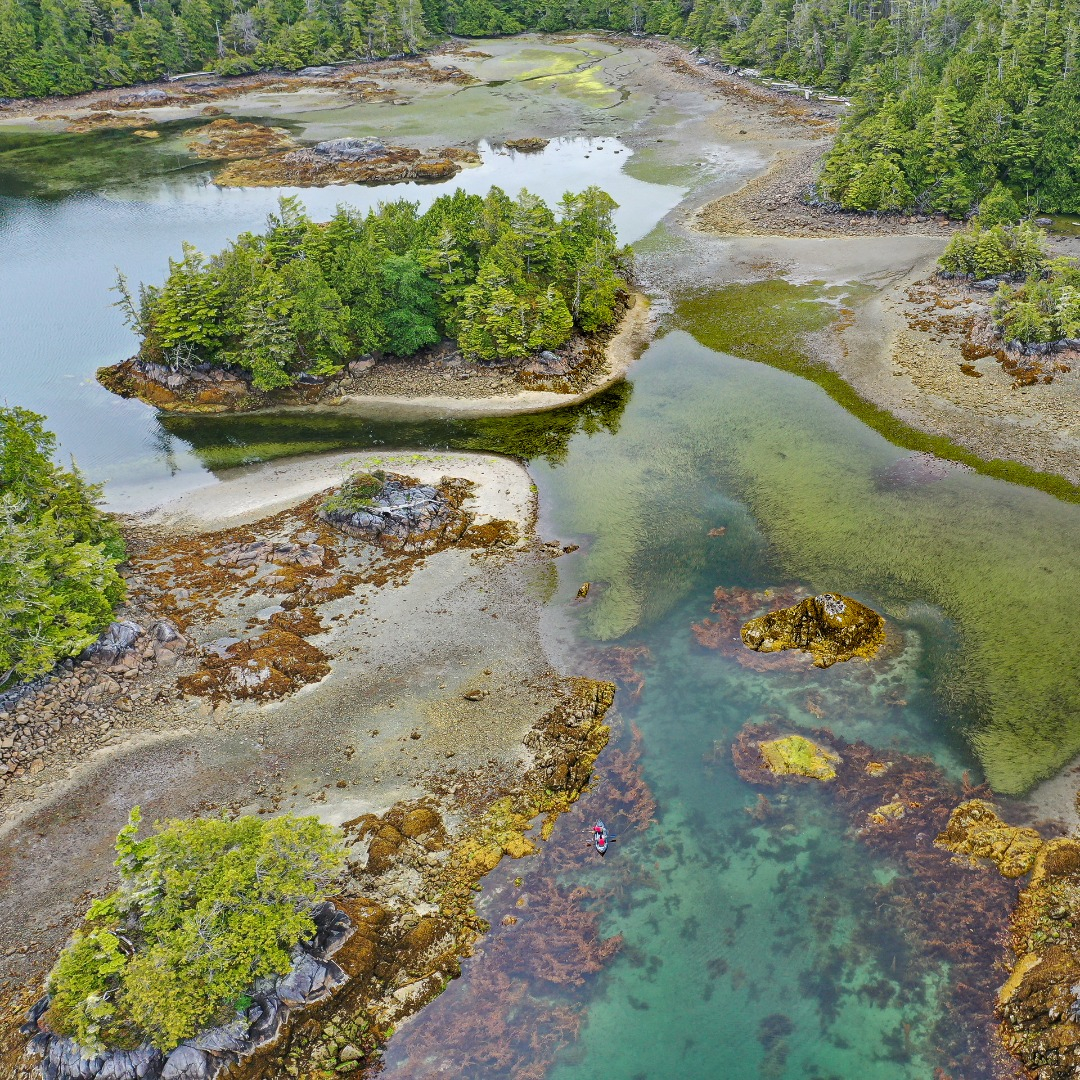
Blue Carbon
HABITATS
Salt marshes, eelgrass meadows, and kelp forests are known as blue carbon habitats. These marine ecosystems absorb and store high amounts of carbon that would otherwise be released into the atmosphere. Acting as carbon sinks, BC’s kelp forests can absorb two to four times more carbon than land based forests. Investing in their protection and restoration is key to fighting climate change. Excluding commercial harvest in marine protected areas can help to increase the resilience of kelp and other seaweed to a warmer ocean.
Kelp
FORESTS
Dense underwater kelp forests provide cover from predators, and a habitat for animals like sea otters to hunt. These habitats are important for commercially harvested species such as juvenile cod, crab, and rockfish.
CORAL & SPONGE REEFS
Spong Reefs in Hecate Straight and
QUEEN CHARLOTTE SOUND
In the depths of Hecate Strait and Queen Charlotte Sound, sponge reefs cover over 700 square kilometres (equivalent to Vancouver Island’s Greater Victoria region) of the seafloor and rise up to the height of a six-storey building. The intricate shapes of reefs make perfect nooks for young rockfish and other socially and economically important marine animals. In 2017, the Hecate Strait/Queen Charlotte Sound Glass Sponge Reefs Marine Protected Areawas designated to safeguard the reefs and the marine life they harbour.
Coldwater Corals
AND SPONGES
BC is home to cold water corals and sponges, including unique glass sponge reefs that were once thought to be globally extinct. Coral and sponge reefs create complex structures that provide habitat for many species, much like seagrasses do. They act as nurseries, refuge, and feeding grounds for other marine wildlife, and enhance local biological diversity and abundance.
Glass sponge reefs are an integral part of a healthy marine habitat. These rare and unique marine animals provide shelter for marine life, including rockfish and shrimp, store carbon on the ocean floor, filter bacteria out of the water, and fertilize the ocean. The sea of glass supports thriving culture and livelihoods for coastal communities.
Watch Saving The Sea of Glass in The Salish Sea here.
Corals and sponges are very vulnerable to physical damage from bottom-contact fisheries. For instance, bottom trawling nets and prawn traps easily shatter the fragile skeleton of glass sponge reefs. The Pacific Groundfish Trawl Habitat Agreement between industry, NGOs and the federal government has dramatically curtailed trawling impacts on sensitive coral and sponge reefs. However, some reefs could benefit from proposed marine protected areas that would exclude bottom-contact fisheries. Additionally, these protections could increase reef resilience to climate change. The glass sponge reef near Dundas Island is the largest known reef still unprotected in BC.
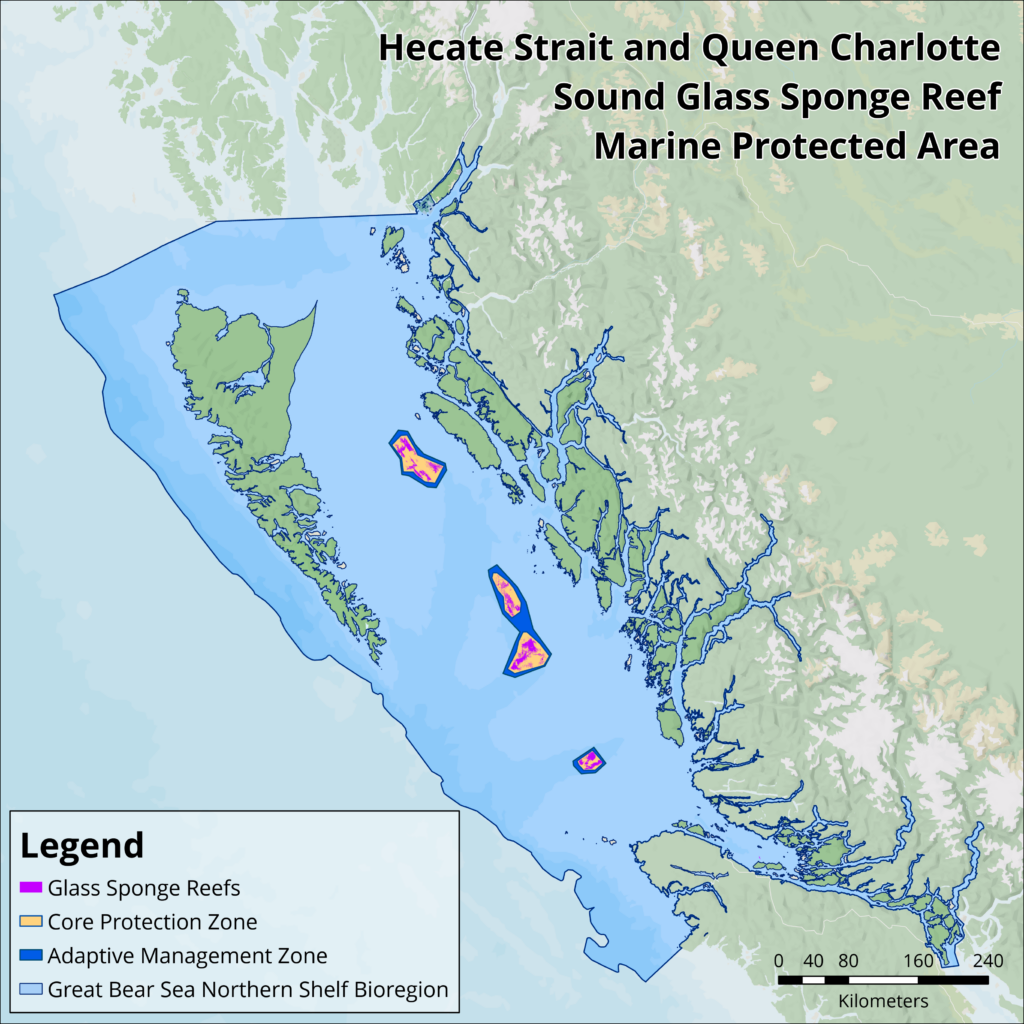
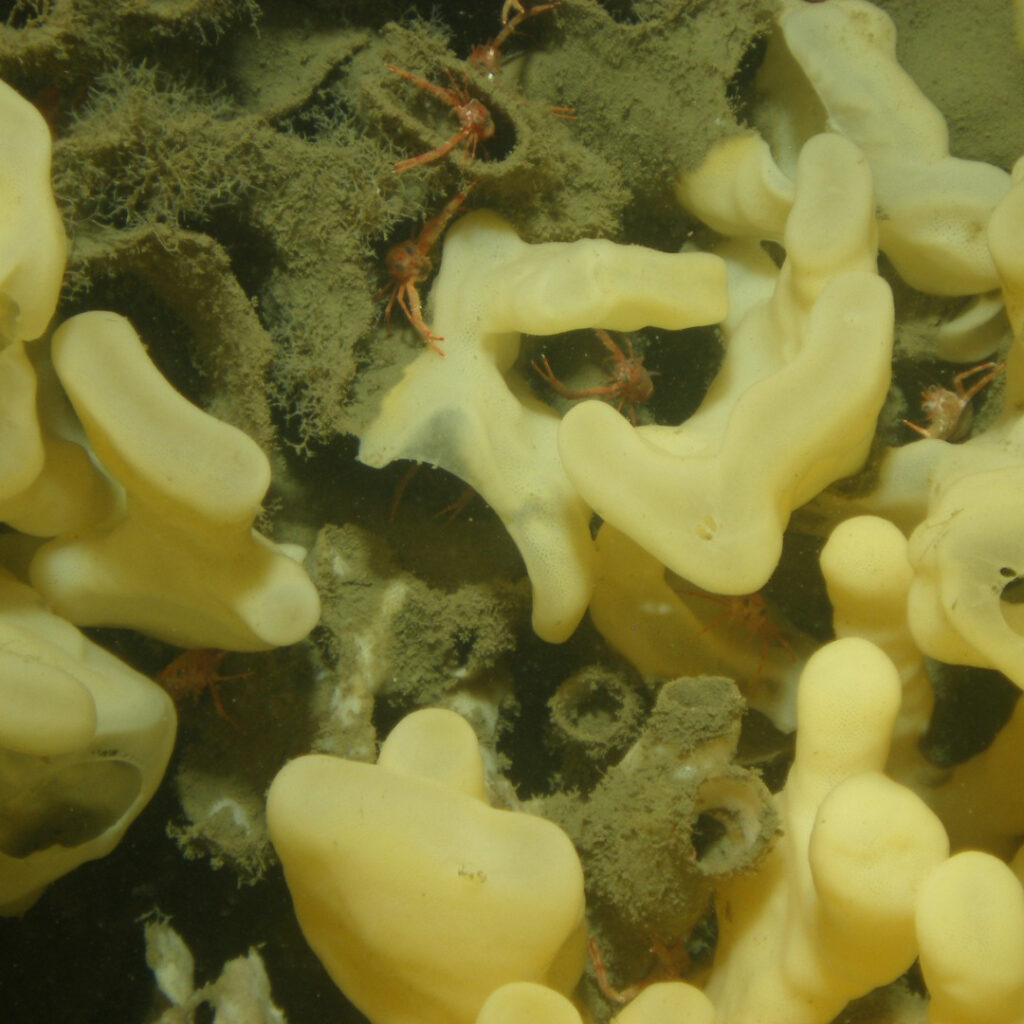
Whales, Dolphines &
PORPOISES
Whales, dolphins, and porpoises – collectively known as cetaceans – live in or migrate through these waters. By feeding on krill, herring, marine mammals and other animals, whales help bring balance to ocean ecosystems. Their feeding also helps fight climate change, with large amounts of carbon stored in their bodies. Cetaceans also help transfer nutrients between the deep ocean and surface waters.
The deep fjords of Douglas Channel provide the perfect habitat for some whale species. These nutrient-rich waters are home to Canada’s highest concentration of humpback and fin whales, two distinct populations of orcas, as well as other marine mammals. The threat of ship strikes and noise disturbance from increased tanker traffic in this area threatens species already at risk.
Listen to the recording of orca sounds drowned out by the propeller noise from a boat here.
Johnstone Strait/Blackfish Sound is critical habitat for northern resident orcas – protection of the area is essential to the survival or recovery of these iconic species North of Vancouver Island. It’s a popular destination for whale watching and other recreational activities like kayaking. Visitors can witness a rare behaviour where orcas rub themselves on shallow barnacle-encrusted rocks, pebbles and gravel seafloor.
Watch underwater footage of the Rubbing Beach.
Healthy whale populations indicate a healthy ocean and some whales like humpbacks have made a remarkable comeback in the region over the last decade. However, other whales show signs of trouble.
The Pacific grey whale population has declined by almost a quarter since 2016. Although the cause of this unusual mortality event is still unknown, scientists suspect one or a combination of climate change impacts on the whales’ food supply, harmful algal blooms, disease, natural predation and human interactions as reasons for such decline.
Every year, humpback whales migrate with their young from Hawaii and Mexico to feed in these thriving waters. They are well known for “bubble-net feeding” in which teams of whales work together blowing a net of bubbles and vocalizing to corral fish. A newly observed feeding method called “trap feeding” has also been recorded off northern Vancouver Island. After having their populations devastated by whaling, humpback numbers are increasing along the BC coast.
The ocean is teeming with marine life.
Let's work together to support a healthy future for our ocean.
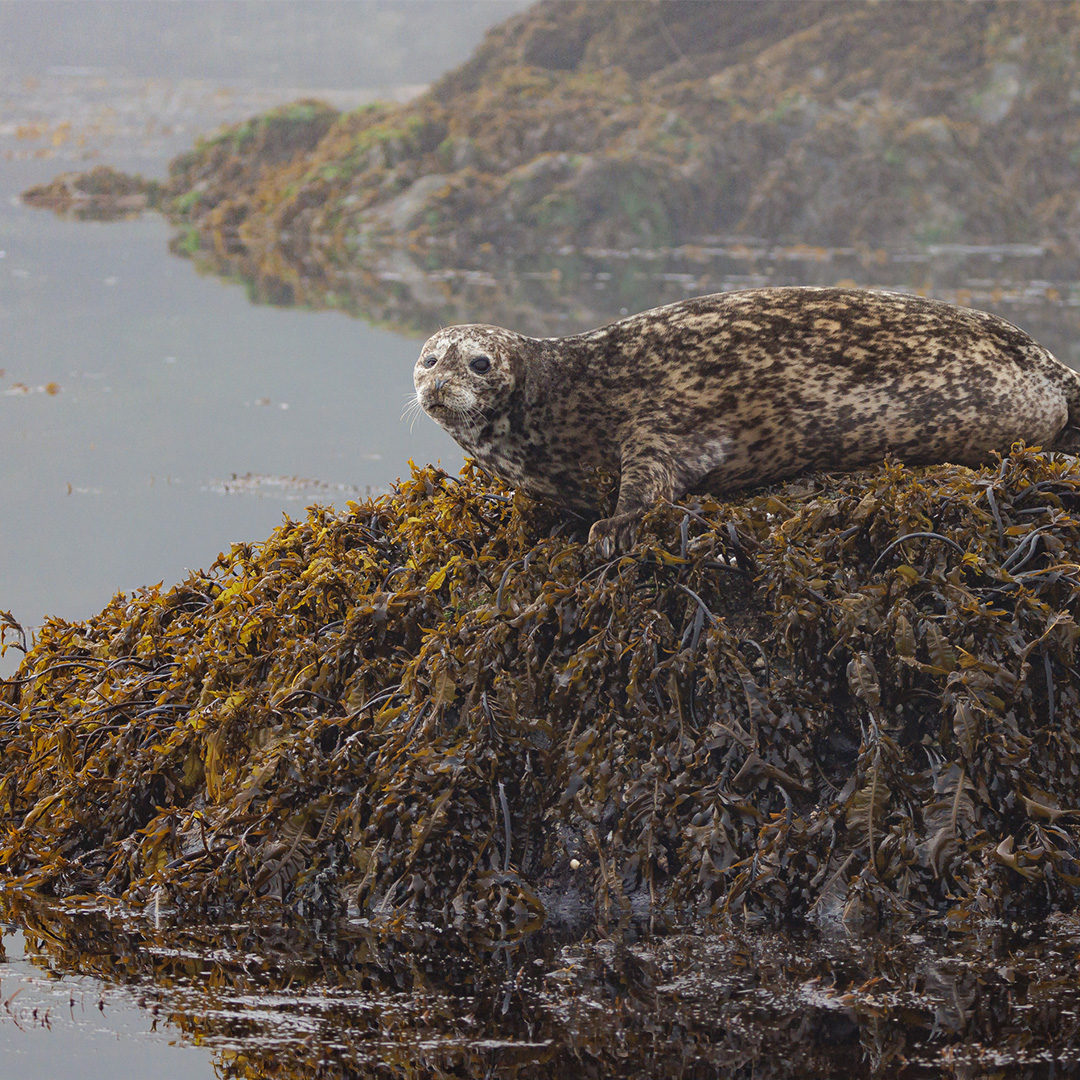
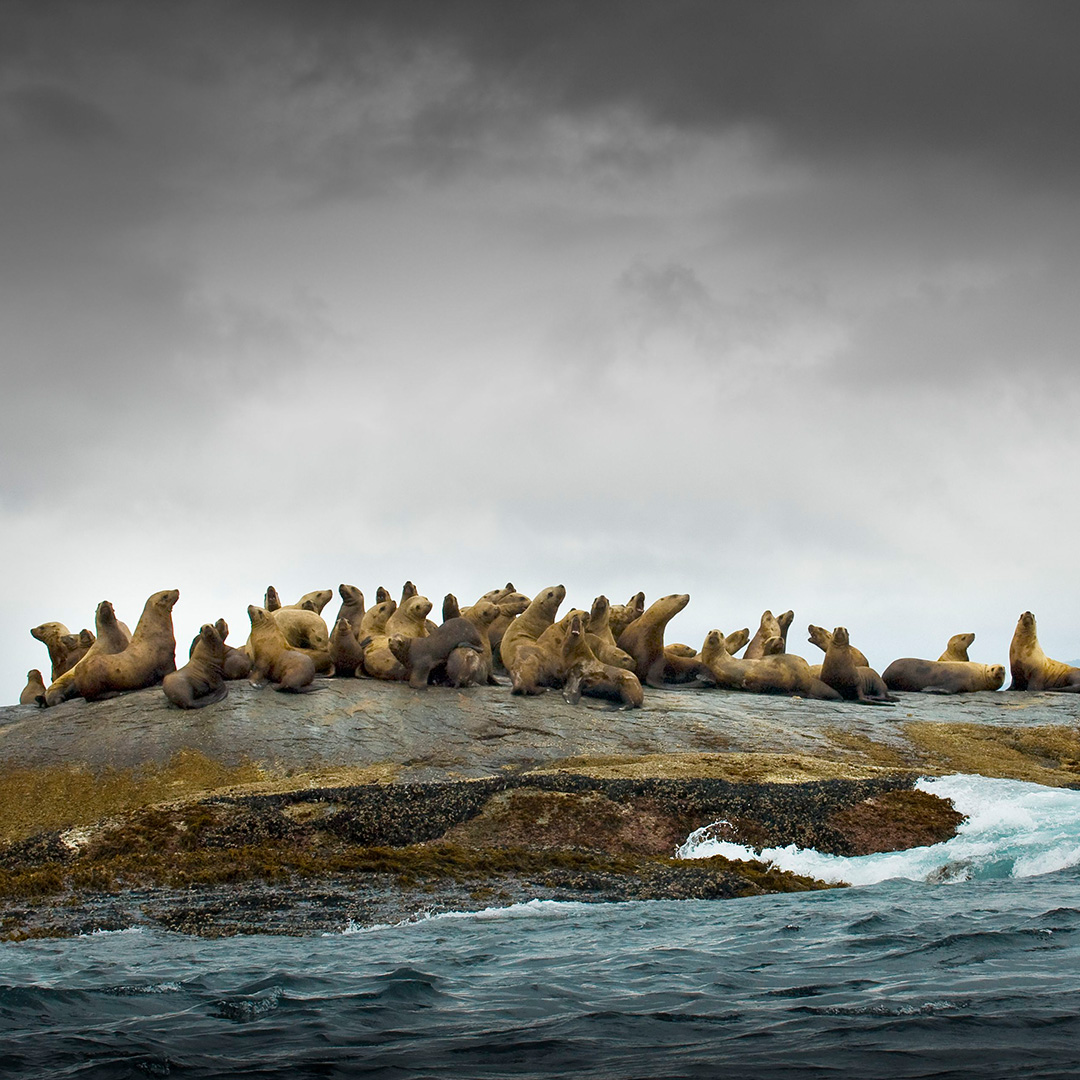
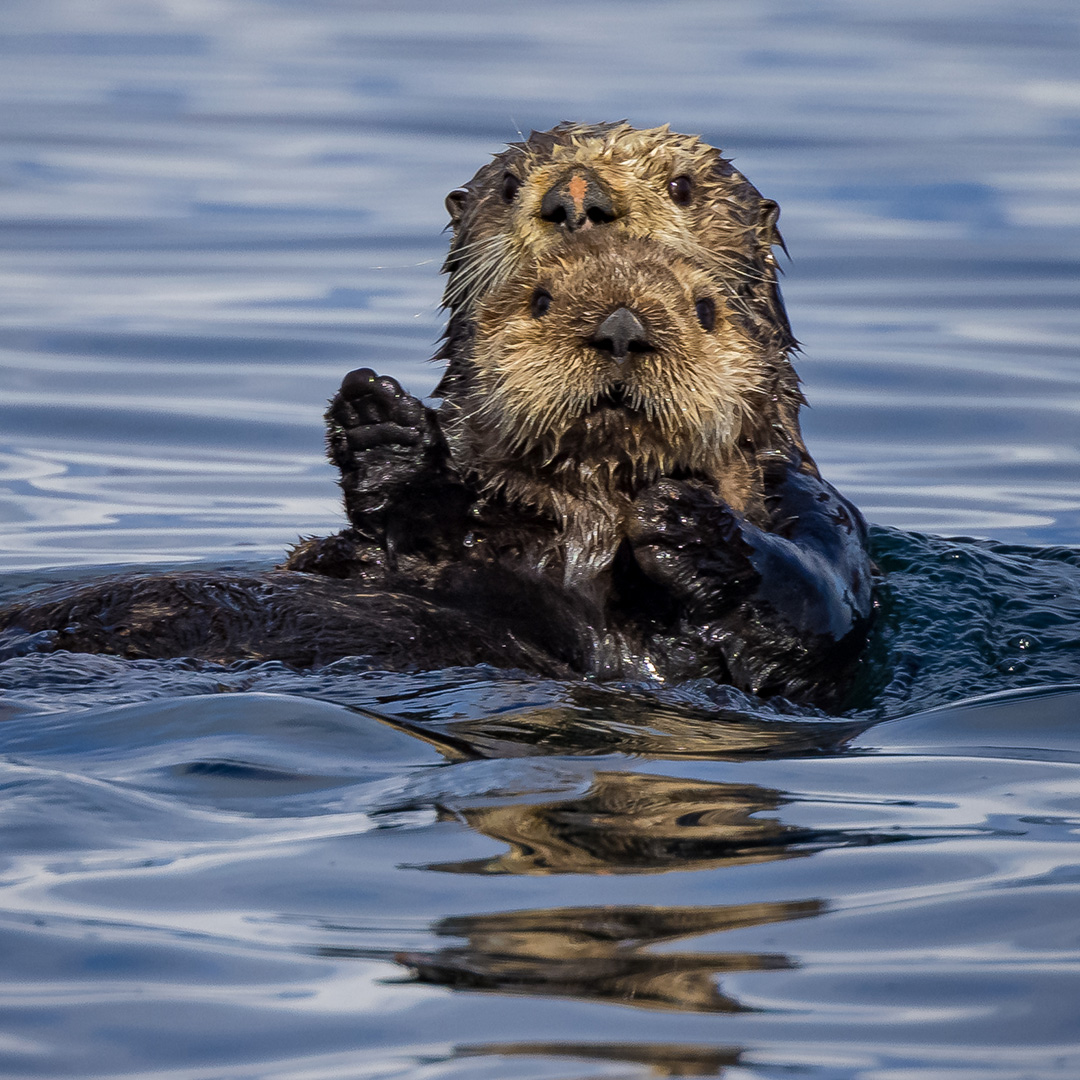
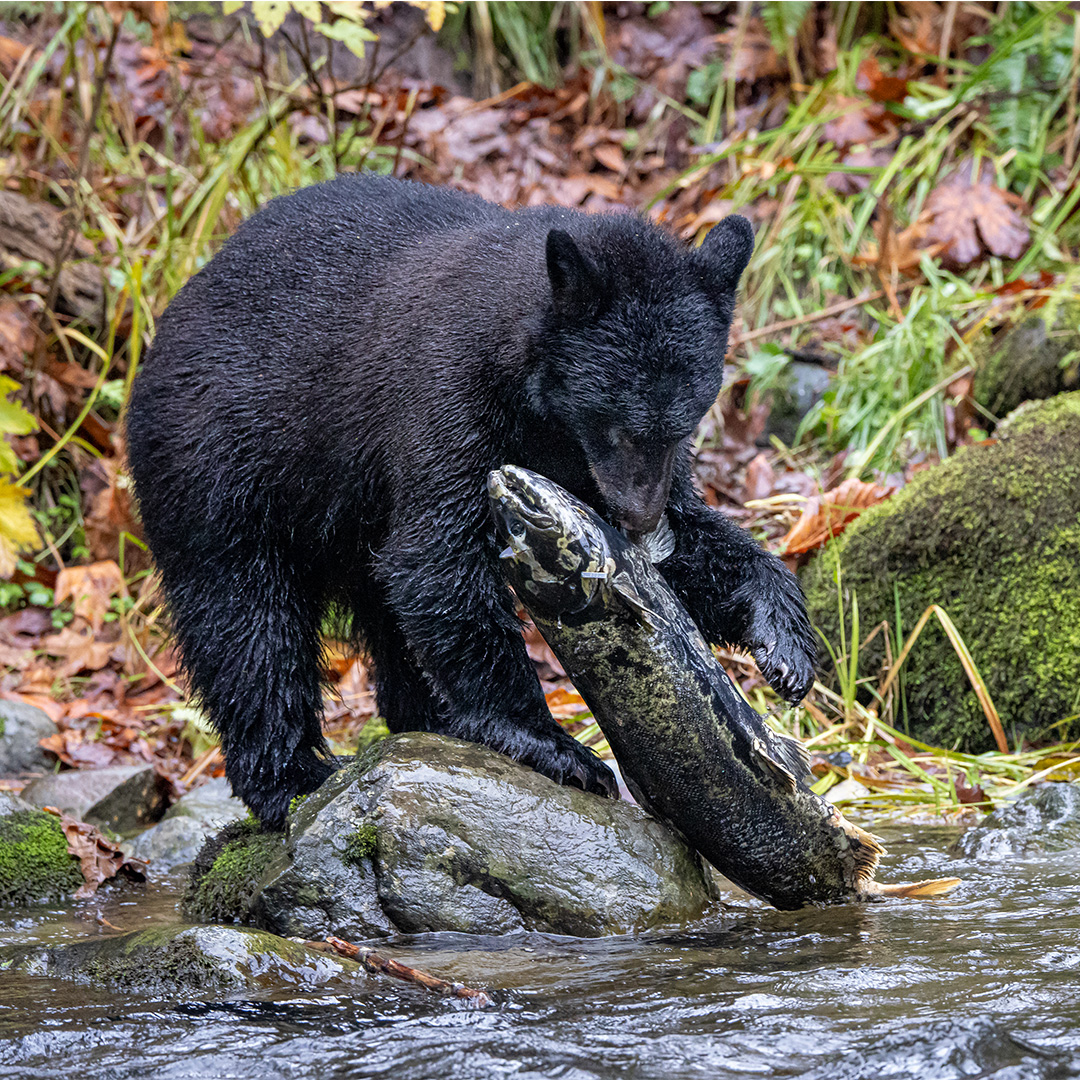
Other Marine
MAMMALS
These waters host a rich abundance and diversity of marine fishes, including many species that are important to First Nations, commercial, and recreational fisheries. Unfortunately, many fisheries have seen dramatic decreases over the years. Marine protected areas can help restore these populations.
These waters are home to many marine mammals, including three species of seal, two species of sea lion, and the northern sea otter. Seals and sea lions, also known as pinnipeds, have specialised flippers and insulating blubber to swim and forage at sea. In contrast, otters are a type of weasel and have webbed feet and the thickest fur of any animal.
Marine
BIRDS
These waters contain a network of internationally recognized Important Bird Areas (IBAs). A whopping 32 of the 84 designated IBAs in BC are in the region.
The Great Bear Sea region is part of the Pacific Flyway – a major route for migratory birds in the Americas. Each fall and spring, hundreds of thousands of birds travel between their breeding grounds in the Arctic and their wintering grounds in Mexico and South America. These migrants rely on the nutrient-rich estuaries and mudflats where freshwater meets the Pacific Ocean to refuel and replenish body fat along their long journey.
These waters contain a network of internationally recognized Important Bird Areas (IBAs). A whopping 32 of the 84 designated IBAs in BC are in the region.
With roughly 1.4 million seabirds, the Scott Islands marine National Wildlife Area supports the largest seabird breeding colonies in BC. These birds include 50% of the global population of Cassin’s auklets, 90% of Canada’s tufted puffins, 95% of Pacific Canada’s common murres, and significant numbers of rhinoceros auklets. These dedicated seabird parents brave the rugged waters to forage out at sea and bring back fish for their hungry chicks. Seabirds from as far away as Japan, Australia, and Chile also come here to feed in the prey-rich waters.
Around 1.5 million seabirds from 12 species nest on Haida Gwaii, including half of the world’s population of Ancient Murrelets. Once an important food source for Haida First Nation, SGin Xaana (night-bird) or Ancient Murrelets, are now a species-at-risk in Canada due to predation and habitat destruction by introduced species.
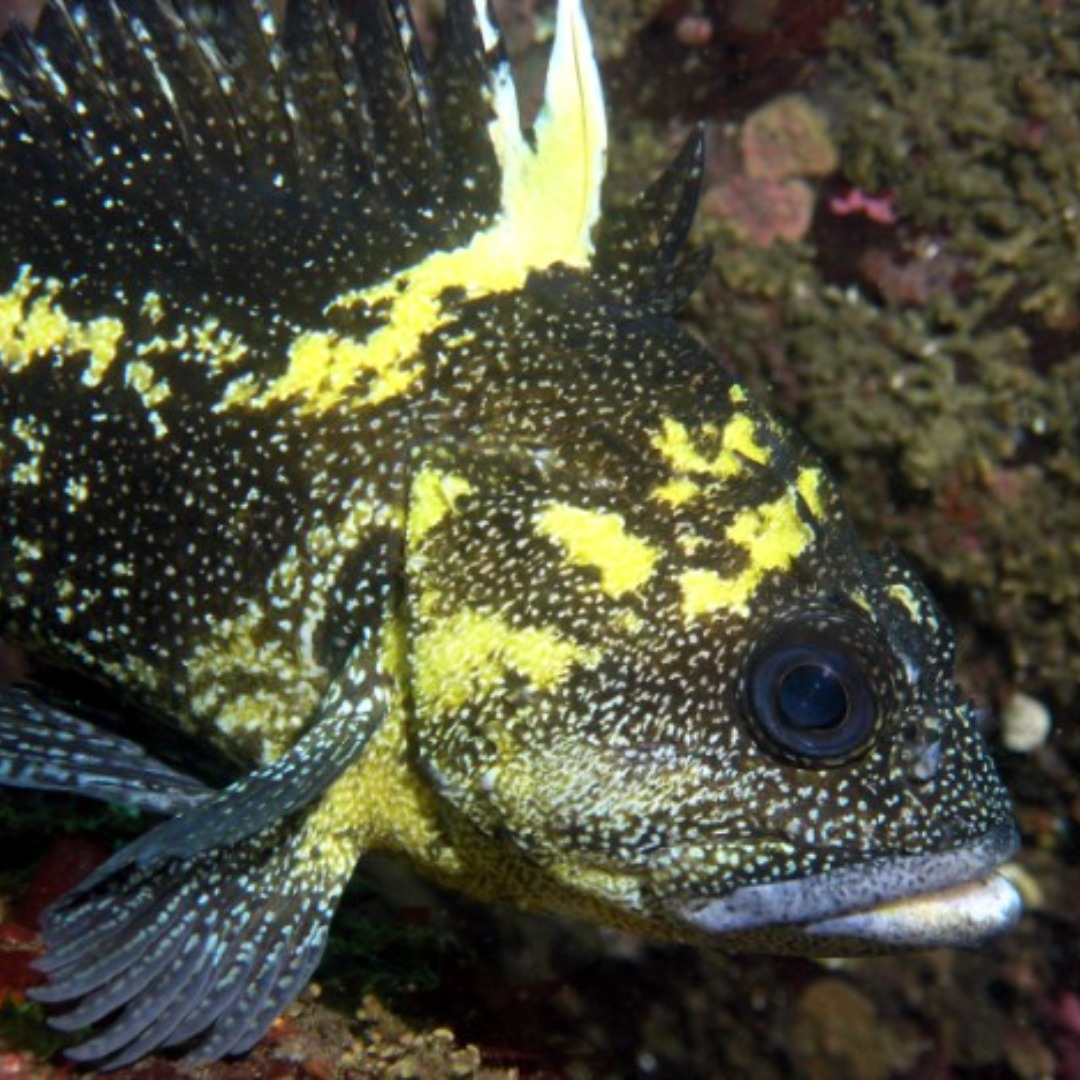
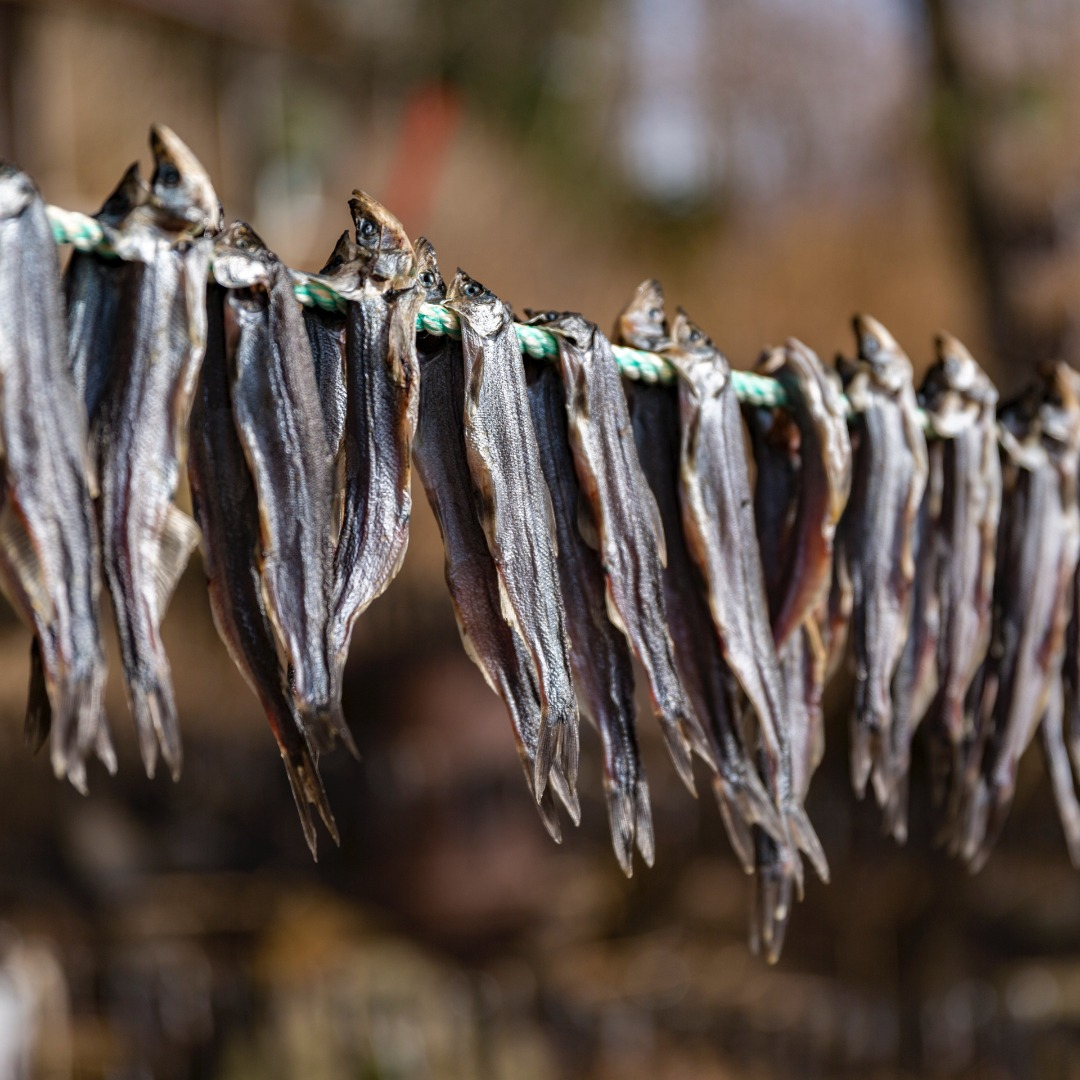

FISH
These waters host a rich abundance and diversity of marine fishes, including many species that are important to First Nations, commercial, and recreational fisheries. Unfortunately, many fisheries have seen dramatic decreases over the years. Marine protected areas can help restore these populations.
All five species of Pacific Salmon are found in the region: chinook, coho, pink, sockeye, and chum salmon.
The Skeena River estuary, consisting of immense mudflats and shallow intertidal passages, provides important nursery habitat for juvenile salmon. Each year, hundreds of millions of juvenile salmon journey through the Skeena River estuary on their way out to sea. At the end of their life cycle, they return to the streams, bringing vital ocean nutrients to streams and forests.
Watch: Salmon Feed Forests
All five species of Pacific Salmon are found in the region: chinook, coho, pink, sockeye, and chum salmon.
The Skeena River estuary, consisting of immense mudflats and shallow intertidal passages, provides important nursery habitat for juvenile salmon. Each year, hundreds of millions of juvenile salmon journey through the Skeena River estuary on their way out to sea. At the end of their life cycle, they return to the streams, bringing vital ocean nutrients to streams and forests.
Watch: Beauty and the Feast
There are 38 species of rockfish along the coast of BC. Rockfish have been fished as a reliable food source for centuries by First Nations and now represent an important fishery for coastal BC.
Some rockfish can live over 100 years, are slow to reproduce, and have incredibly small home ranges (often limited to a few square metres), with divers finding them in the same spot year after year. Marine protected areas, even small ones, can help restore populations and allow them to grow larger.
The eulachon, a small silvery smelt-like fish, has many names: oolichan, ooligan, hooligan. They are a significant food source for a wide variety of fish, birds and mammals– including humans. Marine protected areas that protect spawning areas could help restore eulachon populations.
Watch: Among the Eulachon
INVERTEBRATES
Invertebrates are animals that lack a backbone. They’re the most diverse group of animals in the ocean. Mollusks are a category of invertebrates that include oysters, clams, and octopus. They have a soft body and may have a hard external or internal shell, or lack a shell altogether. Shrimp, lobster and crab belong to a group of invertebrates called crustaceans, which typically possess a body covering or shell. Many species of mollusks and crustaceans are targeted by commercial and recreational fisheries.
Dungeness crab is the largest edible true crab on the Pacific coast and a popular seafood delicacy. They can grow as large as 10 inches across their body. Like other crustaceans, they need to shed their hard exoskeleton to grow.
Dungeness crabs reach sexual maturity quickly and have short life spans. This makes them a good alternative when it comes to sustainable seafood, according to Seafood Watch and Ocean Wise. To ensure the sustainable fishing of this crab in BC, only male crabs that have a body that is 6.5 inches can be taken to ensure that females remain to produce offspring and replenish the population.
The giant Pacific octopus is the largest octopus in the world, usually weighing around 15 kg with arms that reach over 4 metres in length.
Naw náaGalang, or octopus houses, are circular dome-shaped structures on Haida Gwaii that mimic natural octopus dens occurring under large rocks, and used by First Nations to catch the invertebrates for food from time immemorial.
Nudibranchs are sea slugs, famous for the extravagant plume-like extremities on their backs. The bright colors warn predators that they are foul tasting or toxic to eat. Like slugs on land, they use the tentacles on their heads to sense the world around them.
The lion’s mane jellyfish, is the largest jellyfish species on the planet. Its long trailing tentacles can grow longer than a blue whale. Stinging tentacles are used to capture and eat prey like fish, zooplankton, and even other jellyfish.
What are Marine
PROTECTED AREA Networks?
Protecting an area as large as the ocean is a daunting task. That’s why we need a network of government and coastal communities working together to raise the level of protection across the ocean collectively.


